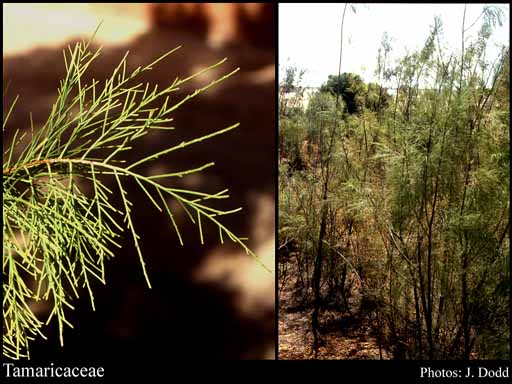- Reference
- Enum. Hort. Berol. Alt. 1:291 (1821)
- Name Status
- Current

Scientific Description
Common name. Tamarix Family.
Habit and leaf form. Small trees, or shrubs, or herbs (rarely, suffrutescent). ‘Normal’ plants, or switch-plants; sometimes with the principal photosynthesizing function transferred to stems. Leaves well developed (but small), or much reduced. Leptocaul. Mostly xerophytic (or halophytic). Leaves minute to small; alternate; spiral; fleshy, or membranous (commonly subulate or scalelike); often imbricate (the plants often heathlike); sessile (sometimes amplexicaul); sheathing, or non-sheathing; commonly with epidermal but embedded, multicellular salt glands; simple; epulvinate. Leaf blades with the lamina commonly centric (when not abortive); entire. Leaves without stipules. Stem anatomy. Secondary thickening developing from a conventional cambial ring.
Reproductive type, pollination. Fertile flowers hermaphrodite, or functionally male, or functionally female. Unisexual flowers present, or absent. Plants hermaphrodite, or dioecious.
Inflorescence and flower features. Flowers solitary (Hololachne, Reaumuria), or aggregated in ‘inflorescences’; when aggregated, in racemes, or in spikes, or in panicles; ebracteate; small; regular; 4–5(–6) merous (when A ‘definite‘); cyclic. Free hypanthium absent. Hypogynous disk present, or absent; extrastaminal, or intrastaminal, or extrastaminal and intrastaminal; of separate members, or annular. Perianth with distinct calyx and corolla; 8, or 10, or 12; 2 -whorled; isomerous. Calyx present; 4, or 5(–6); 1 -whorled; polysepalous (usually), or gamosepalous (sometimes connate below); conspicuously lobed; blunt-lobed. Calyx lobes markedly longer than the tube. Calyx imbricate; regular; persistent. Corolla present; 4, or 5(–6); 1 -whorled; appendiculate (each petal of Reaumuria with a pair of scalelike appendages inside at the base), or not appendiculate; polypetalous; imbricate; regular; white, or pink; persistent, or deciduous. Fertile stamens present, or absent (from female flowers). Androecial members definite in number, or indefinite in number. Androecium 4–6, or 8–12 (often twice as many as the petals), or 15–100 (often more or less ‘numerous’). Androecial members branched (when numerous), or unbranched. Androecial sequence determinable, or not determinable. Androecial members free of the perianth; free of one another, or coherent (when many, often joined basally into bundles); when bundled, 1 - adelphous, or 5 - adelphous. Androecium exclusively of fertile stamens. Stamens 4–6, or 8–12 (commonly twice as many as the petals), or 15–100 (often more or less ‘numerous’); isomerous with the perianth to polystemonous; fertile stamens representing when ‘definite‘, the anterior-lateral pair; when ‘definite‘, oppositisepalous. Anthers dorsifixed; dehiscing via longitudinal slits; extrorse, or latrorse, or introrse; tetrasporangiate. Pollen shed in aggregates, or shed as single grains; when in aggregates, in tetrads. Fertile gynoecium present, or absent (from male flowers). Gynoecium (2–)3–4(–5) carpelled. The pistil 1 celled, or (2–)3–4(–5) celled. Carpels reduced in number relative to the perianth, or isomerous with the perianth. Gynoecium syncarpous; synovarious, or synstylovarious; superior. Ovary unilocular; 1 locular (but the placental partitions sometimes sufficiently deeply intruded to simulate loculi, especially basally and apically); sessile. Gynoecium non-stylate (the stigmas sessile in Myricaria), or stylate. Styles when present, (2–)3–4(–5); free, or partially joined; apical. Stigmas (2–)3–4(–5); wet type; non-papillate; Group IV type. Placentation parietal, or basal to parietal (Tamarix). Ovules in the single cavity 4–100 (2–‘many’ on each placenta); funicled; ascending; anatropous.
Fruit and seed features. Fruit non-fleshy; dehiscent; a capsule. Capsules loculicidal. Seeds scantily endospermic, or non-endospermic. Endosperm not oily (starchy). Seeds conspicuously conspicuously hairy (covered with long hairs, or these forming a coma at one end); with starch. Embryo well differentiated. Cotyledons 2. Embryo straight. Seedling. Germination phanerocotylar.
Physiology, biochemistry. Aluminium accumulation not found. Photosynthetic pathway: C3.
Geography, cytology, number of species. Holarctic and Paleotropical. World distribution: Western and Northern Eurasia, Russia, Middle East, Mediterranean, Eastern and Southern Asia, North Africa, South Africa, Australasia and North America. X = 12. 120 species.